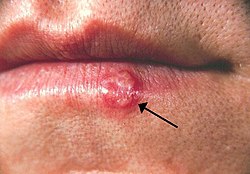Herpes
(The following text or part of it is quoted from the free Wikipedia article Herpes simplex
:)
Herpes simplex is a viral infection caused by the herpes simplex virus. Infections are categorized based on the part of the body infected. Oral herpes involves the face or mouth. It may result in small blisters in groups often called cold sores or fever blisters or may just cause a sore throat.[1] Genital herpes, often simply known as herpes, may have minimal symptoms or form blisters that break open and result in small ulcers. These typically heal over two to four weeks. Tingling or shooting pains may occur before the blisters appear. Herpes cycles between periods of active disease followed by periods without symptoms. The first episode is often more severe and may be associated with fever, muscle pains, swollen lymph nodes and headaches. Over time, episodes of active disease decrease in frequency and severity. Other disorders caused by herpes simplex include: herpetic whitlow when it involves the fingers,[2] herpes of the eye,[3] herpes infection of the brain,[4] and neonatal herpes when it affects a newborn, among others.[5]
References
- ↑
 Mosby: Mosby's Medical Dictionary. Edition: 9. Elsevier Health Sciences. Pp. 836–837. ISBN 9780323112581.
Mosby: Mosby's Medical Dictionary. Edition: 9. Elsevier Health Sciences. Pp. 836–837. ISBN 9780323112581.
- ↑
 Wu, I.B., Schwartz, R.A.. Herpetic whitlow. Cutis. March 2007; 79(3): 193–106. PMID.
Wu, I.B., Schwartz, R.A.. Herpetic whitlow. Cutis. March 2007; 79(3): 193–106. PMID.
- ↑
 Rowe, A.M., St Leger, A.J., Jeon, S., Dhaliwal, D.K., Knickelbein, J.E., Hendricks, R.L.. Herpes keratitis. Progress in Retinal and Eye Research. January 2013; 32: 88–101. PMID. DOI.
Rowe, A.M., St Leger, A.J., Jeon, S., Dhaliwal, D.K., Knickelbein, J.E., Hendricks, R.L.. Herpes keratitis. Progress in Retinal and Eye Research. January 2013; 32: 88–101. PMID. DOI.
- ↑
 Steiner, I., Benninger, F.. Update on herpes virus infections of the nervous system. Current Neurology and Neuroscience Reports. December 2013; 13(12): 414. PMID. DOI.
Steiner, I., Benninger, F.. Update on herpes virus infections of the nervous system. Current Neurology and Neuroscience Reports. December 2013; 13(12): 414. PMID. DOI.
- ↑
 Stephenson-Famy, Gardella, C.. Herpes Simplex Virus Infection During Pregnancy. Obstetrics and Gynecology Clinics of North America. December 2014; 41(4): 601–614. PMID. DOI.
Stephenson-Famy, Gardella, C.. Herpes Simplex Virus Infection During Pregnancy. Obstetrics and Gynecology Clinics of North America. December 2014; 41(4): 601–614. PMID. DOI.
